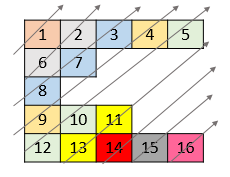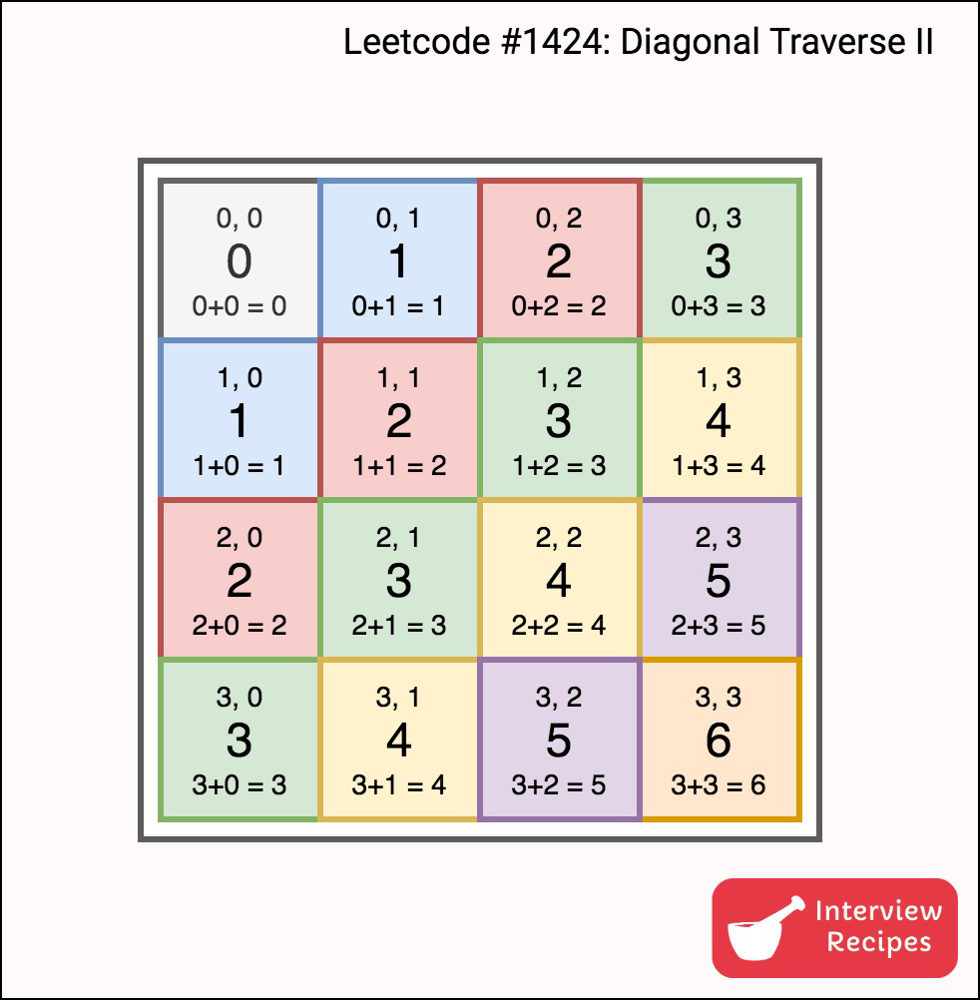LeetCode 1424. Diagonal Traverse II
原题链接在这里:https://leetcode.com/problems/diagonal-traverse-ii/description/
题目:
Given a 2D integer array nums, return all elements of nums in diagonal order as shown in the below images.
Example 1:

Input: nums = [[1,2,3],[4,5,6],[7,8,9]] Output: [1,4,2,7,5,3,8,6,9]
Example 2:

Input: nums = [[1,2,3,4,5],[6,7],[8],[9,10,11],[12,13,14,15,16]] Output: [1,6,2,8,7,3,9,4,12,10,5,13,11,14,15,16]
Constraints:
1 <= nums.length <= 1051 <= nums[i].length <= 1051 <= sum(nums[i].length) <= 1051 <= nums[i][j] <= 105
题解:
In the matrix, when index sum i + j is equal, then elements with equal sum index are on the same printing line.

Have a map to maintain the index sum and its elements.
Print from small to large index sum, for each list, print from the end.
Time Complexity: O(m * n). m = nums.size(). n is average length of list in the nums.
Space: O(m * n).
AC Java:
1 class Solution { 2 public int[] findDiagonalOrder(List<List<Integer>> nums) { 3 int count = 0; 4 int maxKey = 0; 5 HashMap<Integer, ArrayList<Integer>> hm = new HashMap<>(); 6 for(int i = 0; i < nums.size(); i++){ 7 for(int j = 0; j < nums.get(i).size(); j++){ 8 int sum = i + j; 9 hm.computeIfAbsent(sum, k -> new ArrayList<Integer>()).add(nums.get(i).get(j)); 10 count++; 11 maxKey = Math.max(maxKey, sum); 12 } 13 } 14 15 int[] res = new int[count]; 16 int ind = 0; 17 for(int i = 0; i <= maxKey; i++){ 18 if(hm.containsKey(i)){ 19 List<Integer> ls = hm.get(i); 20 for(int j = ls.size() - 1; j >=0; j--){ 21 res[ind++] = ls.get(j); 22 } 23 } 24 } 25 26 return res; 27 } 28 }



【推荐】国内首个AI IDE,深度理解中文开发场景,立即下载体验Trae
【推荐】博客园2025新款「AI繁忙」系列T恤上架,前往周边小店选购
【推荐】凌霞软件回馈社区,携手博客园推出1Panel与Halo联合会员
【推荐】轻量又高性能的 SSH 工具 IShell:AI 加持,快人一步